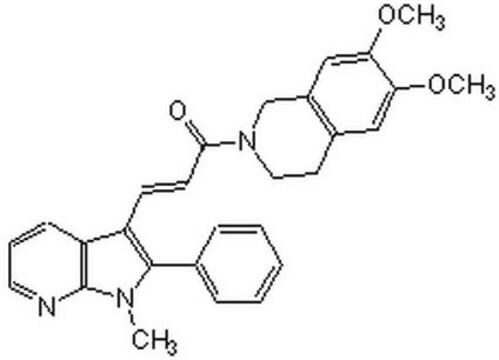Kluczowe dokumenty
T0307
Tyloxapol
BioXtra
Synonim(y):
4-(1,1,3,3-Tetramethylbutyl)phenol polymer with formaldehyde and oxirane
About This Item
Polecane produkty
opis
non-ionic
Poziom jakości
linia produktu
BioXtra
zanieczyszczenia
<0.0005% Phosphorus (P)
pozostałość po prażeniu
<1.0%
CMC
0.018 mM
temp. przejścia
cloud point 94.3 °C
ślady anionów
chloride (Cl-): <0.05%
sulfate (SO42-): <0.6%
ślady kationów
Al: <0.0005%
Ca: <0.0005%
Cu: <0.0005%
Fe: <0.001%
K: <0.005%
Mg: <0.0005%
NH4+: <0.05%
Na: <0.5%
Pb: <0.001%
Zn: <0.0005%
ciąg SMILES
[H]C([H])=O.OCCO.CC(C)(C)CC(C)(C)c1ccc(O)cc1
InChI
1S/C14H22O.C2H6O2.CH2O/c1-13(2,3)10-14(4,5)11-6-8-12(15)9-7-11;3-1-2-4;1-2/h6-9,15H,10H2,1-5H3;3-4H,1-2H2;1H2
Klucz InChI
GWJOFBXSBDVUMH-UHFFFAOYSA-N
Szukasz podobnych produktów? Odwiedź Przewodnik dotyczący porównywania produktów
Opis ogólny
Zastosowanie
Hasło ostrzegawcze
Warning
Zwroty wskazujące rodzaj zagrożenia
Zwroty wskazujące środki ostrożności
Klasyfikacja zagrożeń
Eye Irrit. 2 - Skin Irrit. 2 - STOT SE 3
Organy docelowe
Respiratory system
Kod klasy składowania
10 - Combustible liquids
Klasa zagrożenia wodnego (WGK)
WGK 2
Temperatura zapłonu (°F)
235.4 °F - closed cup
Temperatura zapłonu (°C)
113 °C - closed cup
Środki ochrony indywidualnej
Eyeshields, Gloves, type ABEK (EN14387) respirator filter
Wybierz jedną z najnowszych wersji:
Masz już ten produkt?
Dokumenty związane z niedawno zakupionymi produktami zostały zamieszczone w Bibliotece dokumentów.
Klienci oglądali również te produkty
Nasz zespół naukowców ma doświadczenie we wszystkich obszarach badań, w tym w naukach przyrodniczych, materiałoznawstwie, syntezie chemicznej, chromatografii, analityce i wielu innych dziedzinach.
Skontaktuj się z zespołem ds. pomocy technicznej















